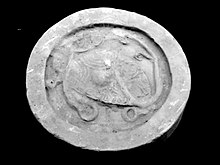| Black Turtle-Snake | |||||||||||||||
|---|---|---|---|---|---|---|---|---|---|---|---|---|---|---|---|
 The Black Tortoise depicted on a Chinese tile | |||||||||||||||
| Chinese name | |||||||||||||||
| Chinese | 玄武 | ||||||||||||||
| Literal meaning | Mysterious ~ Dark ~ Black Warrior | ||||||||||||||
| |||||||||||||||
| Vietnamese name | |||||||||||||||
| Vietnamese alphabet | Huyền Vũ | ||||||||||||||
| Chữ Hán | 玄武 | ||||||||||||||
| Korean name | |||||||||||||||
| Hangul | 현무 | ||||||||||||||
| Hanja | 玄武 | ||||||||||||||
| |||||||||||||||
| Japanese name | |||||||||||||||
| Kanji | 玄武 | ||||||||||||||
| Hiragana | げんぶ | ||||||||||||||
| |||||||||||||||
| Black Warrior of the North | |||||||
|---|---|---|---|---|---|---|---|
 A copper Black Tortoise from the Yongle era of the Ming dynasty (early 15th century) | |||||||
| Chinese | 北方玄武 | ||||||
| |||||||
The Black Tortoise is one of the Four Symbols of the Chinese constellations. It is usually depicted as a tortoise intertwined with a snake.[1] The character '武' can mean 'martial' or 'warrior.' The two characters 玄 and 武 do not have any literal meaning of tortoise and snake. But both tortoise and snake are known to hibernate during winter. The image of intertwined tortoise and snake likely symbolizes a state of inner struggle[citation needed] or a state of hibernation, and thus implies the season of winter. So the English translation Black ~ Dark ~ Mysterious Warrior[a] is a more faithful translation.[4][5]
It represents the north and the winter season, thus it is sometimes called Black Warrior of the North (Chinese: 北方玄武; pinyin: Běifāng Xuánwǔ).
In Japan, the characters 玄武 are pronounced as Genbu. It is said to protect Kyoto on the north side, being one of the four guardian spirits that protect the city. It is represented by the Kenkun Shrine, which is located on top of Mount Funaoka in Kyoto.
An important Taoist priest also has 玄武 Xuanwu as his clergy name. He is sometimes (as in Journey to the West) portrayed in the company of a turtle and a snake.
- ^ Chen, Sanping; Mair, Victor H. (2017-04-02). "A "Black Cult" in Early Medieval China: Iranian-Zoroastrian Influence in the Northern Dynasties". Journal of the Royal Asiatic Society. 27 (2): 208. doi:10.1017/s1356186316000584. ISSN 0035-869X. S2CID 164550058.
- ^ Liu An (compiler), Xu Shen (annotator). Huainanzi, "Survey Obscurities". Main text: 「夫死生同域, 不可脅陵, 勇武一人, 為三軍雄.」; Annotation: 「武士也; 江淮間謂士曰武.」; Siku Quanshu version. vols. 4–7, p. 96 of 160
- ^ Liu An (2010) The Huainanzi: A Guide to the Theory and Practice of Government in Early Han China. Translated and edited by John S. Major, Sarah A. Queen, Aandrew Seth Meyer, and Harold D. Roth. New York: Columbia University Press, 2010. p. 215
- ^ Zhang, Qian (2017). "China's guardians of the galaxy". Shanghai Daily.
The four beasts are Qing Long (Azure Dragon), the guardian of the East; Bai Hu (White Tiger), the guardian of the West; Zhu Que (Vermilion Bird), the guardian of the South; and Xuan Wu (Black Warrior), the guardian of the North. This quartet originated from the 28 xingxiu ("mansions") in the Chinese constellation system.
- ^ Pregadio, Fabrizio (editor) (2008). The Encyclopedia of Taoism A–Z: Volume 1 & 2. pp. 119, 194, 223, 478, 909, 1266
Cite error: There are <ref group=lower-alpha> tags or {{efn}} templates on this page, but the references will not show without a {{reflist|group=lower-alpha}} template or {{notelist}} template (see the help page).